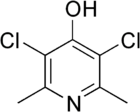 | |
 | |
| Clinical data | |
|---|---|
| Trade names | Coyden, Clobek(Animate Animal Health) |
| AHFS/Drugs.com | International Drug Names |
| ATCvet code | |
| Identifiers | |
IUPAC name
| |
| CAS Number | |
| PubChem CID | |
| ChemSpider | |
| UNII | |
| KEGG | |
| ChEMBL | |
| CompTox Dashboard (EPA) | |
| ECHA InfoCard | 100.019.099 |
| Chemical and physical data | |
| Formula | C7H7Cl2NO |
| Molar mass | 192.04 g·mol |
| 3D model (JSmol) | |
SMILES
| |
InChI
| |
| (what is this?) (verify) | |
Clopidol is an inorganic compound that is used as in veterinary medicine as a coccidiostat. It is prepared industrially by a multistep process from dehydroacetic acid.
The US National Institute for Occupational Safety and Health has set a recommended exposure limit (REL) for clopidol at 10 mg/m TWA (time-weighted average) for total exposure, 5 mg/m TWA for respiratory exposure, and 20 mg/m for short-term exposure. The Occupational Safety and Health Administration has set a permissible exposure limit (PEL); the respiratory PEL is the same as the REL, but the total exposure limit is 15 mg/m.
References
- Miller R, Abaecherli C, Said A, Jackson B (June 2000). "Ketenes". Ullmann's Encyclopedia of Industrial Chemistry. Weinheim: Wiley-VCH. doi:10.1002/14356007.a15_063. ISBN 3527306730.
- "Clopidol". Pocket Guide to Chemical Hazards. NIOSH.
This article is a stub. You can help Misplaced Pages by expanding it. |